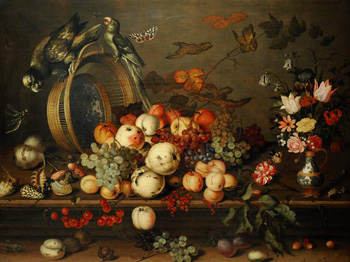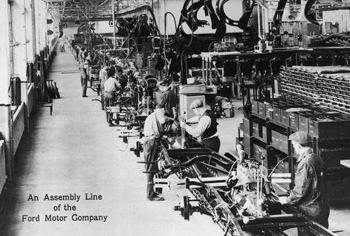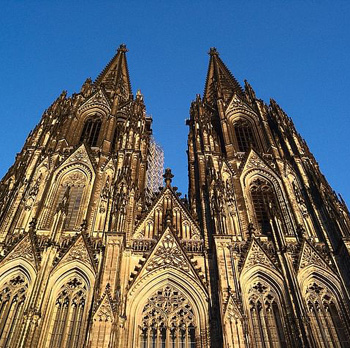Catholic Virtues
 |
 |
 |
 |
 |
 |
 |
True & False Paths to Happiness - XVIII
The Search for the Profound Meaning
of Things
How does a man ascend to God in this life? This is a grand question.
God created the universe according to a plan, in which each being has its own meaning – one could say its own message – that points toward Him.
Thus, everything in the universe has a profound meaning. And that profound sense of each thing draws us to the highest point. If one seeks the final threads in each thing that gives it its meaning, one finds the true profundity of each being.
 That is what the artist does. He takes the meaning of certain things and represents it in a work of art, accentuating certain features a bit in order to show not only its deeper aspects, but also what is hidden there inside.
That is what the artist does. He takes the meaning of certain things and represents it in a work of art, accentuating certain features a bit in order to show not only its deeper aspects, but also what is hidden there inside.
For example, let us look at a still life, let us say a fruit basket with a jar behind it. In day to day life it is usually something banal that we hardly pay attention to. But the true artist captures the meaning of each orange and each apple in that basket, and then the jar, and gives it relevance in a suggestive way.
We may not have the artistic talent to do the same, but this does not prevent us from mentally penetrating the meaning of all these beautiful images that God exposes in this book which is the universe.
Let us give another example with music. Something censurable in certain singers is the fact that they get caught up in exercises of pure virtuosity and exhibition, and are not concerned about the serious, moral, divine meaning of what they do.
 And so it is in all things.
And so it is in all things.
I remember the confusion I felt in my first chemistry classes. The professor – in fact, an atheist, who liked to introduce himself as such – stated, "An emerald is nothing but xyz," the mathematical chemical formula of the stone; adding that this was the deepest knowledge one could have of an emerald.
I sat there thinking. I looked at my colleagues and they appeared absolutely normal, as if the professor had just said that an insect was flying outside. How could it be? A man states that an emerald is reduced to this, and that this formula is the most important aspect of the emerald, and he calls this profound knowledge!
Now, the more profound meaning of things is not reached by grinding them into numerical formulas, but by analyzing them. And analyzing them means to look for something that is not the practical aspect. This analysis is something that men who love the practical and earthly life would call useless, but which in fact constitutes the meaning of life and prepares the soul for Heaven.
Finding eternal principles in beings & situations
It could also be said that the meaning of a thing, when it becomes well-known, is the light of the thing. This light is perceived either in a purely analytical way – that is, by a rational analysis of what it is – or in a symbolic way.
 While the Greco-Roman world strove to enrich the few objects at its disposal with meaning, the modern industrial type of society strives to improve technology to construct more and more objects. Thus there was a waning in the terrain of meanings.
While the Greco-Roman world strove to enrich the few objects at its disposal with meaning, the modern industrial type of society strives to improve technology to construct more and more objects. Thus there was a waning in the terrain of meanings.
Medieval cathedrals, on the contrary, were true masterpieces of symbolism: Everything in them has symbolic meaning. As historian Émile Mâle notes in his work The Gothic Image: "Everything in this [medieval] art speaks through symbols. It shows us one thing and invites us to see something else there." (1)
Étienne Gilson goes so far as to say: “For a thinker of the time, to know or to explain something always consisted in showing that it is not what it seems to be, that it is a symbol and sign of a deeper reality, that it announces or signifies something else." (2)
It was once aptly said of Winston Churchill that his universe is made up of simple units that are larger than life. His themes are repetitive like those of an epic poet or, at times, like those of a thaumaturge who sees in beings and situations symbols outside of time and incarnations of eternal and brilliant principles.
This observation is very deep. It is, indeed, wonderful to see "in beings and situations" symbols of "eternal and brilliant principles!" Today's society tends to imply that such persons are dreamers, useless men, outside of reality. On the contrary, Churchill was a man who had great vision, he was an operative man in the highest degree.
At depth, as a personality it was he who won World War II. A completely practical man, a doer, a fighter, a man of action, but also one who led his whole life having before him, as an ideal, "symbols outside of time."
The true work of art refers to God
Dante says that works of art are "granddaughters" of God. For, since the human soul is the daughter of God, what the human spirit engenders is the "grandchild" of God.
 Man, creating "grandchildren" of God – which is what true works of art are – is preparing for the moment when he will appear before the eternal Judge, the eternal Truth and the eternal Beauty. Then he will soar with enthusiasm towards God.
Man, creating "grandchildren" of God – which is what true works of art are – is preparing for the moment when he will appear before the eternal Judge, the eternal Truth and the eternal Beauty. Then he will soar with enthusiasm towards God.
Edgar de Bruyne rightly notes: "In the aesthetics of Hugh de Saint Victor, the symbolic beauty is the fundamental beauty. Every form has an aesthetic value insofar as, directly or indirectly, it brings to mind the Infinite, the Perfect, the Ideal." (3)
Therefore, something is beautiful not so much because it is pleasing, but above all because it refers to God.
The beautiful is a symbol of good; true beauty symbolizes good; consequently, true art symbolizes morality, which is the conformity of human actions with the order established by God.
 Continued
Continued

God created the universe according to a plan, in which each being has its own meaning – one could say its own message – that points toward Him.
Thus, everything in the universe has a profound meaning. And that profound sense of each thing draws us to the highest point. If one seeks the final threads in each thing that gives it its meaning, one finds the true profundity of each being.

Still Life with Fruits, Shells and Insects, 1620s, by Balthasar van der Ast
For example, let us look at a still life, let us say a fruit basket with a jar behind it. In day to day life it is usually something banal that we hardly pay attention to. But the true artist captures the meaning of each orange and each apple in that basket, and then the jar, and gives it relevance in a suggestive way.
We may not have the artistic talent to do the same, but this does not prevent us from mentally penetrating the meaning of all these beautiful images that God exposes in this book which is the universe.
Let us give another example with music. Something censurable in certain singers is the fact that they get caught up in exercises of pure virtuosity and exhibition, and are not concerned about the serious, moral, divine meaning of what they do.

How can one reduce the beauty of the diamonds of the Poltimore Tiara to a chemical formula?
I remember the confusion I felt in my first chemistry classes. The professor – in fact, an atheist, who liked to introduce himself as such – stated, "An emerald is nothing but xyz," the mathematical chemical formula of the stone; adding that this was the deepest knowledge one could have of an emerald.
I sat there thinking. I looked at my colleagues and they appeared absolutely normal, as if the professor had just said that an insect was flying outside. How could it be? A man states that an emerald is reduced to this, and that this formula is the most important aspect of the emerald, and he calls this profound knowledge!
Now, the more profound meaning of things is not reached by grinding them into numerical formulas, but by analyzing them. And analyzing them means to look for something that is not the practical aspect. This analysis is something that men who love the practical and earthly life would call useless, but which in fact constitutes the meaning of life and prepares the soul for Heaven.
Finding eternal principles in beings & situations
It could also be said that the meaning of a thing, when it becomes well-known, is the light of the thing. This light is perceived either in a purely analytical way – that is, by a rational analysis of what it is – or in a symbolic way.

A cold auto factory mass-producing car parts; below, Cologne Cathedral, everything points upward to God

Medieval cathedrals, on the contrary, were true masterpieces of symbolism: Everything in them has symbolic meaning. As historian Émile Mâle notes in his work The Gothic Image: "Everything in this [medieval] art speaks through symbols. It shows us one thing and invites us to see something else there." (1)
Étienne Gilson goes so far as to say: “For a thinker of the time, to know or to explain something always consisted in showing that it is not what it seems to be, that it is a symbol and sign of a deeper reality, that it announces or signifies something else." (2)
It was once aptly said of Winston Churchill that his universe is made up of simple units that are larger than life. His themes are repetitive like those of an epic poet or, at times, like those of a thaumaturge who sees in beings and situations symbols outside of time and incarnations of eternal and brilliant principles.
This observation is very deep. It is, indeed, wonderful to see "in beings and situations" symbols of "eternal and brilliant principles!" Today's society tends to imply that such persons are dreamers, useless men, outside of reality. On the contrary, Churchill was a man who had great vision, he was an operative man in the highest degree.
At depth, as a personality it was he who won World War II. A completely practical man, a doer, a fighter, a man of action, but also one who led his whole life having before him, as an ideal, "symbols outside of time."
The true work of art refers to God
Dante says that works of art are "granddaughters" of God. For, since the human soul is the daughter of God, what the human spirit engenders is the "grandchild" of God.

The rose window in the Cathedral
of Our Lady in Tournai
Edgar de Bruyne rightly notes: "In the aesthetics of Hugh de Saint Victor, the symbolic beauty is the fundamental beauty. Every form has an aesthetic value insofar as, directly or indirectly, it brings to mind the Infinite, the Perfect, the Ideal." (3)
Therefore, something is beautiful not so much because it is pleasing, but above all because it refers to God.
The beautiful is a symbol of good; true beauty symbolizes good; consequently, true art symbolizes morality, which is the conformity of human actions with the order established by God.

An ambience should invite us to find
its symbolic content

- Apud Painton Cowen, Roses Medievales, Paris: Seuil, 1979, p. 81.
- Ibid.
- Apud Marcel Aubert, Le Gothique à son Apogée, Paris: Ed. Albin Michel,1969, pp. 11-12.
- Études d’Esthétique Mediévale, Brugges (Belgium), De Tempel, 1946, vol. 2, p. 216.
Posted October 7, 2020





